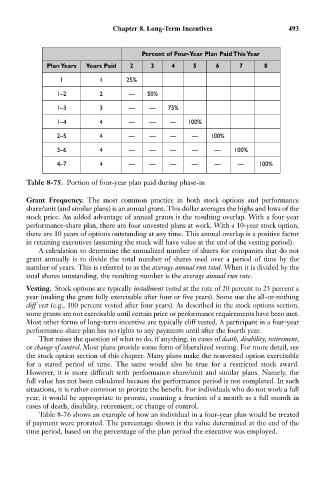Page 507 - Bruce Ellig - The Complete Guide to Executive Compensation (2007)
P. 507
Chapter 8. Long-Term Incentives 493
Percent of Four-Year Plan Paid This Year
Plan Years Years Paid 2 3 4 5 6 7 8
1 1 25%
1–2 2 — 50%
1–3 3 — — 75%
1–4 4 — — — 100%
2–5 4 — — — — 100%
3–6 4 — — — — — 100%
4–7 4 — — — — — — 100%
Table 8-75. Portion of four-year plan paid during phase-in
Grant Frequency. The most common practice in both stock options and performance
share/unit (and similar plans) is an annual grant. This dollar averages the highs and lows of the
stock price. An added advantage of annual grants is the resulting overlap. With a four-year
performance-share plan, there are four unvested plans at work. With a 10-year stock option,
there are 10 years of options outstanding at any time. This annual overlap is a positive factor
in retaining executives (assuming the stock will have value at the end of the vesting period).
A calculation to determine the annualized number of shares for companies that do not
grant annually is to divide the total number of shares used over a period of time by the
number of years. This is referred to as the average annual run total. When it is divided by the
total shares outstanding, the resulting number is the average annual run rate.
Vesting. Stock options are typically installment vested at the rate of 20 percent to 25 percent a
year (making the grant fully exercisable after four or five years). Some use the all-or-nothing
cliff vest (e.g., 100 percent vested after four years). As described in the stock options section,
some grants are not exercisable until certain price or performance requirements have been met.
Most other forms of long-term incentive are typically cliff vested. A participant in a four-year
performance-share plan has no rights to any payments until after the fourth year.
That raises the question of what to do, if anything, in cases of death, disability, retirement,
or change of control. Most plans provide some form of liberalized vesting. For more detail, see
the stock option section of this chapter. Many plans make the nonvested option exercisable
for a stated period of time. The same would also be true for a restricted stock award.
However, it is more difficult with performance share/unit and similar plans. Namely, the
full value has not been calculated because the performance period is not completed. In such
situations, it is rather common to prorate the benefit. For individuals who do not work a full
year, it would be appropriate to prorate, counting a fraction of a month as a full month in
cases of death, disability, retirement, or change of control.
Table 8-76 shows an example of how an individual in a four-year plan would be treated
if payment were prorated. The percentage shown is the value determined at the end of the
time period, based on the percentage of the plan period the executive was employed.

